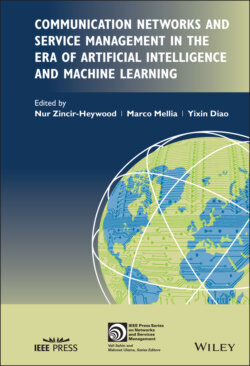Читать книгу Communication Networks and Service Management in the Era of Artificial Intelligence and Machine Learning - Группа авторов - Страница 33
2.1 Overview
ОглавлениеAs the computer and network technologies improve, the ability to acquire, access, store, and process huge amounts of data from physical distant/near locations also increase. For example, people with smartphones connected all the time to different social media systems, exchanging text, voice, photos, and videos at any time and any place. This typically amounts to gigabytes to terabytes of data every day on social networking platforms. This stored data becomes useful when it is analyzed and turned into information such as for prediction, correlation, etc. To this end, artificial intelligence (AI) and machine learning (ML) have become the techniques that are increasingly employed over the years [1–3].
AI is in most part logic based [4]. AI aims to make computers do the types of things that humans' minds can do. These include but are not limited to reasoning, planning, prediction, association, perception, etc. which enable humans to achieve their goals. There are several major types of AI from classical or symbolic AI to ML, each includes many variations. Classical/symbolic AI models planning and reasoning and can also model learning. It is based on the spirit of Turing machine combined with propositional logic and the theory of neural synapses. Complex propositions are built, and deductive arguments are carried out by using logical operators to describe reasoning systems. Expert systems, knowledge bases, and case base reasoning are some examples of classical AI. Expert systems mimic the decision‐making process of a human expert. The program would ask an expert in a field how to respond in a given situation, and once this was learned for a sufficient range of situations, non‐experts could receive advice from that program. These programs would be used for creating knowledge bases which then may be used for decision support systems for different application areas. Case‐based reasoners solve new problems by retrieving stored “cases” describing similar prior problem‐solving episodes and adapting their solutions to fit new needs. Over the years, we have seen applications of expert systems and case‐based reasoning systems in network and service management [5–7].
On the other hand, ML is data driven [8]. It means programming to optimize performance criteria using examples of data or past experience. In ML, there exists a model defined by some parameters, then the learning becomes the execution of a program to optimize the parameters of the model using the training data or the past experience. Past experience case is distinct from either supervised or unsupervised learning because credit assignment is subject to delays. Thus, it is not immediately apparent which behaviors should be rewarded or penalized. This issue is specific to reinforcement learning. The model could be predictive to make predictions in the future, or it could be descriptive to gain knowledge from data, or it could be both. ML uses statistical theory to guide model building in order to infer from the training data or the past experience. In training, efficient algorithms are necessary to solve the optimization problem as well as to store and process the data/past experience. Moreover, the model that is learned at the end of training is required to have efficient representation and solution for inference purposes, possibly in real time. In some applications of ML, the efficiency of the learning and inference model, in other words the space and time complexity could be as important as its prediction accuracy. The growth of network technologies for easy access to data, cheaper access to CPU power, and fast access to data storage has enabled the use of ML algorithms in network and service management [9, 10].
